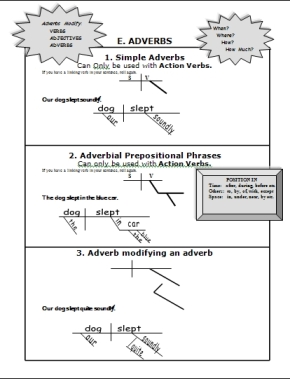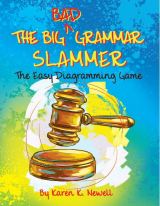Parts of Speech Review
Parts of Speech: The Writer's Tools
Just as carpenters and artists have tools they use to create their constructions, a writer also has tools that are used to craft effective, meaningful sentences.Each part of speech shows how words are related to the other words and phrases in each sentence. These can be manipulated and changed to make a sentence more active or passive, develop suspense, or suggest a problem.
Unfortunately, many of us learned these tools by circling nouns or prepositional phrases in a workbook. That type of activity does not always translate into a writer's skill of using grammar to create a dynamic sentence.
The Big Bad Grammar Slammer introduces each of the parts individually, then has the student identify how other writers use them, and then write their own sentences with that tool.

The 8 Parts of Speech in English
These parts of speech are presented and reviewed in different modules:Nouns - Person, place, thing, or idea
In Module B we cover the simple nouns first: common, proper, compound, and personal pronoun. We also present the complicated nouns: infinitive, gerunds, and relative clauses. Look scary? They are simply nouns with more words and a fancy name.Adjectives - Describe a Noun
Just what the writer was looking for a descriptive adjective. (Don't look now, but in that phrase, "descriptive" was the adjective, and "adjective" was the noun. Really, now. Maybe I should just say "descriptive word" and be a little less confusing.In Module C we teach simple adjectives and compound adjectives and prepositional phrases as adjectives. Just for fun we had participial phrases and relative clauses. Hey, they are just adjectives there to help you understand the nouns a little bit better.
Verbs are Action Words
You are used to simple verbs: eat, swing, sit, think.The problem is that we seldom use such simple verbs, at least once we have finished early reading books. We have been reading other verb tenses for so long, we don't even realize it.
Did you catch the verb phrase "have been reading" in that last sentence? It is a present perfect progressive verb tense. Don't need to be worried, it still is an action verb, so all you have to do is treat it like one.
Adverbs Modify Verbs (and adjectives and adverbs)
Once you have happily recognized the verb phrase, you will gladly add descriptive adverbs.Of course, you recognized that happily and gladly were adverbs. But did you know that very simple, adjectives can be quite easily modified by adverbs?
Prepositions are In Prepositional Phrases
You will find those prepositions:- At the front of prepositional phrases
- Behind verbs
- In front of verbs
- Around nouns
- Throughout the paragraph
- Under headings
- All over the place
Help, interjections are here.
What, you don't know what an interjection is?Yes, you use them all the time. No, they are not hard to write or identify.
You will learn how to easily recognize and diagram them in Module F. In fact, my dear, you will also learn about direct addresses, questions, and quotations in Module F.
Conjections - And, Or, But, So
Everyone knows that "and" and "or" are conjunctions, but they do not always realize that "but" or "so" also are conjunctions used to develop compound sentences.Module G is specially written to help with compound and complex sentences. These master sentences are the ones that really communicate the complex ideas you have in your head, so writing them expertly will make you a master craftsman.
Order Grammar Slammer
The Parts of Speech and Diagramming Game

Learn more about The Big Bad Grammar Slammer, the fun homeschool grammar tutorial and game. It is easy to use, focuses on learning grammar and parts of speech for writing, and makes diagramming sentences fun and simple. No memorization needed, just follow the pattern provided on the Clue Cards. It is economically priced and available in three formats.
BOTH Formats Have Identical Content and Pages
Order the Soft Bound Edition
- Non-consumable, 5th to 12th grade
- The paperback cover makes the book easy to use and store on your shelf
- 8 1/2 x 11" Paperback
- $14.95
Order the Popular E-book
About Our Site
Hands-On Learning














New! Comments
Share your feedback with the rest of the home school community.